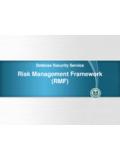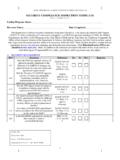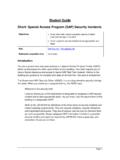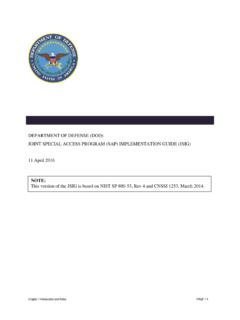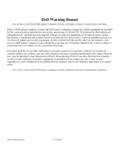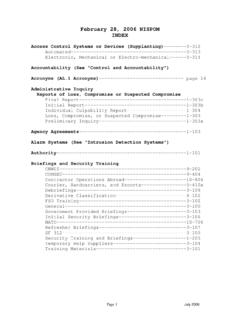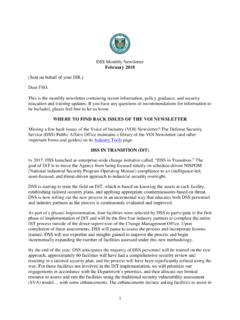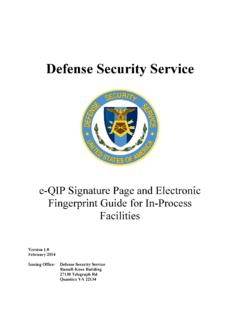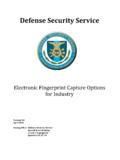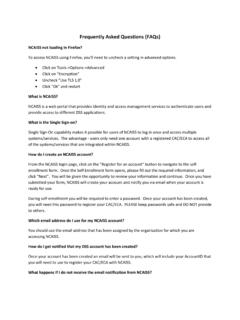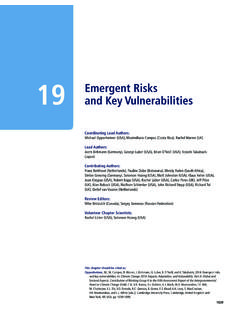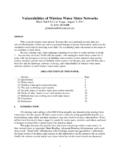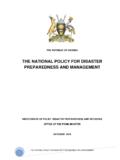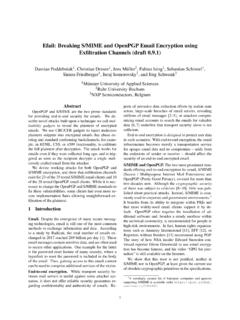Transcription of 2013 DSS Vulnerability Assessment Rating Matrix ...
1 Please submit any questions or comments to 1 2013 DSS Vulnerability Assessment Rating Matrix vulnerabilities and NISP Enhancement Categories Table of Contents Vulnerability Assessments .. 2 vulnerabilities .. 3 NISP Enhancements .. 4 1 Company Sponsored 5 2 Internal Educational 6 3 Security Staff Professionalization .. 7 4 Information/Product Sharing w/in Community .. 8 5 Active Membership in Security Community .. 9 6 Contractor Self-Review .. 10 7 CI 11 8 FOCI/International .. 12 9 Classified Material Controls/Physical Security.
2 13 10 Information Systems .. 14 Please submit any questions or comments to 2 Vulnerability Assessments Overview: The National Industrial Security Program (NISP) was established by Executive Order 12829 to ensure that cleared defense industry safeguards the classified information in their possession while performing work on contracts, programs, bids, or research and development efforts. DSS administers the NISP on behalf of the Department of Defense and 25 other federal agencies. There are approximately 13,300 contractor facilities that are cleared for access to classified information.
3 Per National Industrial Security Program Operating Manual (NISPOM) 1-206, Security Reviews, DSS performs Vulnerability assessments of all cleared contractor facilities under its cognizance. The focus of Vulnerability assessments is to ensure facilities are compliant with NISPOM requirements such that safeguards employed by contractors are adequate for the protection of classified information. During an Assessment a team comprising of one or more DSS Industrial Security Representatives, Information System Security Professionals, and Field Counterintelligence Specialists will review the contractor s security program as it relates to each chapter of the NISPOM and interview personnel.
4 Throughout the Assessment DSS will identify vulnerabilities and NISP Enhancements (detailed on the following pages). At the end of each Assessment , DSS will review the identified vulnerabilities and enhancements and, taking in to consideration the size and complexity of the facility s program, identify an Assessment Rating of Superior, Commendable, Satisfactory, Marginal, or Unsatisfactory. Below is a breakdown of assessments performed and ratings granted in FY12. Following each Assessment DSS will provide the Facility Security Officer (FSO) a list of identified vulnerabilities , NISPOM reference, and recommended action to remedy.
5 DSS will then continue to follow up and work with the FSO to help mitigate any outstanding issues. In the rare case of a Marginal or Unsatisfactory Rating , DSS will notify the facility s government customers for classified contracts who may discontinue or suspend contract performance. DSS will conduct a compliance Assessment within 60 to 120 days to evaluate the facilities corrective actions to identified vulnerabilities . A satisfactory Rating will be awarded and government customers notified at the conclusion of the compliance Assessment if the vulnerabilities have been mitigated.
6 These ratings are infrequent and it is the DSS goal to partner with industry, ensuring strong security programs are in place to protect classified information. Please submit any questions or comments to 3 vulnerabilities Definition: If a contractor is not in compliance with the requirements of the NISPOM, DSS will identify the issue as either an "Acute Vulnerability ", a "Critical Vulnerability " or a " Vulnerability ." The following further defines each category: Acute Vulnerability : Those vulnerabilities that put classified information at imminent risk of loss or compromise, or that have already resulted in the compromise of classified information.
7 Acute vulnerabilities require immediate corrective action. Critical Vulnerability : Those instances of NISPOM non-compliance vulnerabilities that are serious, or that may foreseeably place classified information at risk or in danger of loss or compromise. Once a Vulnerability is determined to be Acute or Critical, it shall be further categorized as "Isolated", "Systemic", or "Repeat": o Isolated - Single occurrence that resulted in or could logically lead to the loss or compromise of classified information.
8 O Systemic -Deficiency or deficiencies that demonstrate defects in a specific subset of the contractor's industrial security program ( , security education and awareness, AIS security) or in the contractor's overall industrial security program. A systemic critical Vulnerability could be the result of the contractor not having a required or necessary program in place, the result of an existing process not adequately designed to make the program compliant with NISP requirements, or due to a failure of contractor personnel to comply with an existing and adequate contractor policy.
9 These defects in either a subset or the overall program may logically result in either a security violation or administrative inquiry if not properly mitigated. o Repeat - Is a repeat of a specific occurrence identified during the last DSS security Assessment that has not been properly corrected ( a specific document, system, personnel, etc. issue was identified and reported corrected by the contractor facility but upon the next Assessment the exact same document, system, person, etc. the Vulnerability still exists).
10 Note: Although some repeat vulnerabilities may be administrative in nature and not directly place classified information at risk to loss or compromise, it is documented as critical. Vulnerability : All instances of non-compliance with the NISPOM that are not acute or critical vulnerabilities . For the purposes of Rating Matrix scoring, multiple instances of vulnerabilities identified under the same NISPOM reference will be counted as one item. For example, multiple documents not properly marked as required in 4-203.
